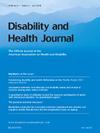Exploring the increased prevalence of autism in the fee-for-service Medicare population with open data, 2007 to 2018
IF 3.3
2区 医学
Q1 HEALTH CARE SCIENCES & SERVICES
引用次数: 0
Abstract
Background
The Autism and Developmental Disabilities Monitoring (ADDM) Network continues to report increases in the percentage of U.S. children identified with autism spectrum disorder (ASD). Few studies, however, have examined prevalence among U.S. adults.
Objective
To use open data on ASD prevalence among fee-for-service Medicare beneficiaries, considering trends in the context of sociodemographic factors and dual enrollment in Medicaid.
Methods
Administrative prevalence estimates from the Centers for Medicare and Medicaid Services (CMS) were used to explore changes in ASD prevalence among fee-for-service Medicare beneficiaries. These rates were compared with corresponding childhood prevalence estimates from the ADDM Network.
Results
In 2018, there were 87,108 fee-for-service Medicare beneficiaries with autism diagnoses, representing a 236.1% increase from 2008. For 8-year-old children in the ADDM Network, the 2008–2018 change was 32.41%. National ASD prevalence increased in the fee-for-service Medicare population every year from 2007 through 2018, most substantially for beneficiaries under the age of 65. While only 10 states had a prevalence at or above 1 in 1000 beneficiaries in 2007, 48 states and the District of Columbia had a prevalence above that value in 2018. Prevalence in the Medicare population also increased from 2016 to 2018, a period in which program enrollment declined.
Conclusions
Even more so than among children, autism prevalence increased in the fee-for-service Medicare population from 2007 through 2018. While geographic and sociodemographic differences in ASD identification existed, prevalence grew across states and most subgroups. Further research is needed to address questions involving the identification and support of autistic adults.
利用公开数据探索2007年至2018年自费医疗保险人群中自闭症患病率的增加。
背景:自闭症和发育障碍监测(ADDM)网络继续报告美国儿童被确诊为自闭症谱系障碍(ASD)的比例有所增加。然而,很少有研究调查了美国成年人的患病率。目的:考虑社会人口因素和双入组背景下的趋势,使用收费医疗保险受益人中ASD患病率的公开数据。方法:使用医疗保险和医疗补助服务中心(CMS)的行政患病率估算值来探索按服务收费的医疗保险受益人中ASD患病率的变化。这些比率与来自ADDM网络的相应儿童患病率估计值进行了比较。结果:2018年,诊断为自闭症的按服务收费的医疗保险受益人有87,108人,比2008年增加了236.1%。对于ADDM网络中的8岁儿童,2008-2018年的变化为32.41%。从2007年到2018年,全国ASD患病率在按服务收费的医疗保险人群中每年都在增加,其中65岁以下的受益人最多。2007年,只有10个州的患病率达到或超过千分之一,而2018年,48个州和哥伦比亚特区的患病率高于这一数值。从2016年到2018年,医疗保险人口的患病率也有所上升,在此期间,该计划的入学率下降。结论:从2007年到2018年,在按服务收费的医疗保险人群中,自闭症患病率的上升幅度甚至超过了儿童。虽然在ASD识别上存在地理和社会人口差异,但患病率在各州和大多数亚组中都有所增长。需要进一步的研究来解决涉及自闭症成年人的识别和支持的问题。
本文章由计算机程序翻译,如有差异,请以英文原文为准。
求助全文
约1分钟内获得全文
求助全文
来源期刊

Disability and Health Journal
HEALTH CARE SCIENCES & SERVICES-PUBLIC, ENVIRONMENTAL & OCCUPATIONAL HEALTH
CiteScore
7.50
自引率
6.70%
发文量
134
审稿时长
34 days
期刊介绍:
Disability and Health Journal is a scientific, scholarly, and multidisciplinary journal for reporting original contributions that advance knowledge in disability and health. Topics may be related to global health, quality of life, and specific health conditions as they relate to disability. Such contributions include:
• Reports of empirical research on the characteristics of persons with disabilities, environment, health outcomes, and determinants of health
• Reports of empirical research on the Systematic or other evidence-based reviews and tightly conceived theoretical interpretations of research literature
• Reports of empirical research on the Evaluative research on new interventions, technologies, and programs
• Reports of empirical research on the Reports on issues or policies affecting the health and/or quality of life for persons with disabilities, using a scientific base.
 求助内容:
求助内容: 应助结果提醒方式:
应助结果提醒方式:


